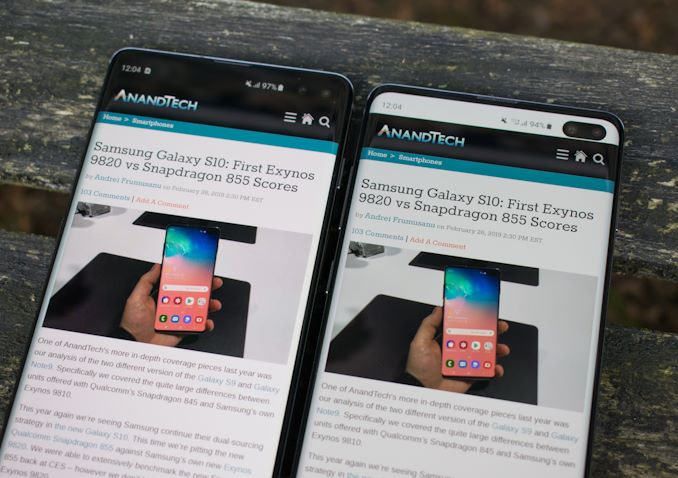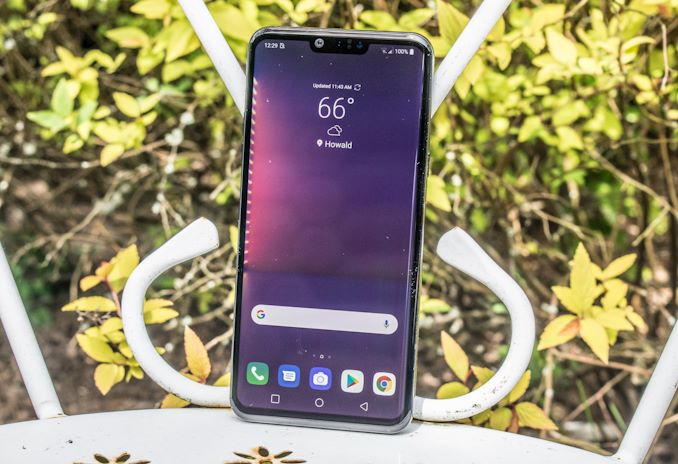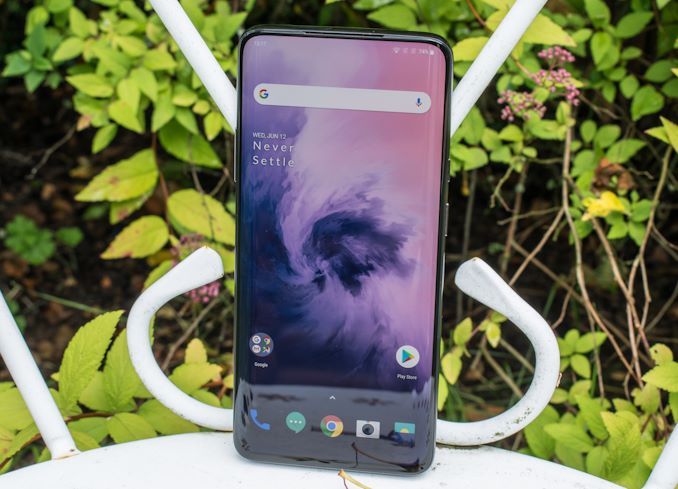The Snapdragon 855 Phone Roundup: Searching for the Best Implementations
by Andrei Frumusanu on September 5, 2019 8:30 AM ESTTop Devices - The Well Knowns
First of all we’ll be going over a brief overview of the various devices, covering their unique aspects and what makes them stand out from the competition.
Samsung Galaxy S10+
Starting off with the Galaxy S10+, the device should really need no introduction. Samsung was among the first vendors to actually employ the Snapdragon 855 this year, and to date has been able to be one of the, if not the most, successful Android devices of the year. The Galaxy S10 is characterized by its new design language with a edge-to-edge screen which includes the much discussed camera cut-out. Further features which mark the Galaxy S10 is the triple-camera setup which includes normal wide-angle, telephoto and ultra-wide-angle lenses which were the top camera performers of this year – at least till time of writing.
Samsung also manage to be exceptionally power efficient this year. The inclusion of a 4100mAh battery was a boon, however Samsung’s very power efficient screen employed in the phone was able to put it ahead of other Android devices when it comes to battery longevity.
The company continues to use a dual-sourcing strategy, using both Qualcomm’s as well as Samsung LSI’s own Exynos chipsets in the same phone. We don’t really know why Samsung does this, as sometimes it can very much dilute R&D efforts to create the same phone with two hardware platforms. The benefit here is that we’re able to have an apples-to-apples comparison device and directly comparing Qualcomm’s Snapdragon SoCs against Samsung’s Exynos chip. This year, the Qualcomm variant yet again managed to be the superior device, delivering an almost flawless experience while the Exynos variant had some rough edges here and there in terms of performance or camera experience.
Read Our Galaxy S10+ Full Review Here
LG G8 ThinQ
LG had also been among the earlier adopters of the Snapdragon 855 in the new LG G8. This year LG was able to greatly improve on the hardware experience compared to the G7 last year. The G8 is also the first in LG’s G-series to come with an OLED screen whereas all previous generations were still using LCDs. LG still has issues with its own OLED panel production as we’ve seen rather lackluster panel power efficiency compared to Samsung or even BOE, of which the G8 also suffers from, ending up with average battery life.
The G8’s camera this year was much improved, and in particular daylight quality was a strength of the phone. LG oddly opted to deliver the G8 with only two camera modules in western markets, the main camera sensor and the wide-angle, reserving the triple-camera variant with the added telephoto module to Korean domestic markets.
Other specialties of the G8 include a new under-screen piezoelectric speaker under the top screen, replacing the traditional earpiece speaker. To date this has been the best implementation of its kind in terms of audio quality, with the new unit being used a stereo speaker. One attempt to differentiate the G8 from other devices was the introduction of a time-of-flight sensor which enabled Minority Report-like gestures to control the phone. Unfortunately I found these to be rather gimmick and offer very little added experience in daily usage of the phone.
Read Our LG G8 Full Review Here
OnePlus 7 Pro
Another popular Snapdragon 855 device this year was the OnePlus 7 Pro. This year marked the first time that OnePlus delivered two device tiers at the same time, putting the 7 Pro a tier higher than the regular new OnePlus 7. The company’s rationale here is that as it matured it’s able to offer more refined experiences and hardware, which in turn come at a higher price point.
The 7 Pro’s key characteristic is its screen, in particular two unique aspects of it. First of all, it’s a bezel-less design without any kind of notch or cut-out, offering a true full-screen experience which gives the phone a very modern look that stands out compared to other 2019 devices. The front-camera is implemented via a mechanical slide-out mechanism at the top of the phone, which is one way of delivering on the bezel-less screen experience.
The other key aspect of the phone is the fact that it’s using a 1440p 90Hz OLED screen – which to date is still unique. The 90Hz experience is in particular something that makes the phone stand out and the single most important key feature of the phone that would want one to use the OnePlus 7 Pro.
Weaknesses of the 7 Pro include the fact that it’s quite the big and hefty device, likely thanks to the internal front-camera sliding mechanism. While OnePlus implemented the 90Hz display in the best way possible, it still comes at a cost to battery life, so even though the phone has a 4000mAh battery, its battery life is relatively in the middle of the pack. Further disappointments were found in the camera department which I blame on lackluster post-processing as well as weakness of the camera sensor.
Read Our OnePlus 7 Pro Full Review Here
Sony Xperia 1
The Sony Xperia 1 was the first Sony device we’ve been able to review here at AnandTech. The phone marks a new start for Sony’s mobile division following an internal reorganization and a few years of lackluster sales.
In terms of design language, the new Xperia 1 is certainly a unique device thanks to its 21:9 screen aspect ratio which I’ve found to offer a great experience. The screen is also the phone’s weakness, as Sony’s decision to go for a 4K panel resolution makes very little sense in practice. Yes, it’s the sharpest screen in the market and the uniformity is quite incredible, however the difference to a 1440p screen is just not noticeable enough. Keep in mind this is coming from somebody who deems 1080p screens in smartphones as being insufficient as I can easily see the pixel matrix. The big negative for the phone is found in its battery life, as the meager battery capacity combined with a power hungry screen makes for some quite disappointing results.
Cameras on the Xperia 1 were also a double-edged sword. On one hand Sony managed to get one of the sharpest and most detailed shots in the market, but at the same time the phone suffered from a bad handling of dynamic range and HDR processing, as well as lacklustre low-light performance.














47 Comments
View All Comments
yeeeeman - Thursday, September 5, 2019 - link
Andrei, this is nice, but we could guesstimate how an 855+ will behave.We really want to see Exynos 9825 since that is harder to estimate.
Andrei Frumusanu - Thursday, September 5, 2019 - link
I don't have the 9825/Note10 yet, we'll have to buy one. Currently this won't happen till maybe October as it's going to be busy with other stuff the next few weeks.LarsBolender - Thursday, September 5, 2019 - link
But you are going to review the 9825, are you?rocketman122 - Thursday, September 5, 2019 - link
all I care about is if the camera is great, and the op7 is garbage as has been all the others before it.FunBunny2 - Thursday, September 5, 2019 - link
"all I care about is if the camera is great"and, how many phone companies make the cameras? it is, of course, just a matter of buying off-the-shelf from other vendors.
IUU - Friday, September 6, 2019 - link
Lol! Couldn't care any less about the camera! But each to his own.cha0z_ - Monday, September 9, 2019 - link
It would make an interesting read to see the benefits going from 8nm to 7nm, but from what is known - the benefits are super slim to even justify doing that in the first place for something different than "beta test" the 7nm for the next year SOC.There are more interesting things that comes like the A13 SOC and the next kirin.
FunBunny2 - Thursday, September 5, 2019 - link
"all I care about is if the camera is great"and, how many phone companies make the cameras? it is, of course, just a matter of buying off-the-shelf from other vendors.
philehidiot - Saturday, September 7, 2019 - link
I look at these charts and I get angrier and angrier about Samsung forcing me into Exynos when the performance (and other subsystems) are really quite inferior. It's marketed as one product but it's two very different phones. I compare this to motorbikes as that's my thing. A 1000cc Fireblade is NOT the same bike as a 650CC version. They are similar in looks and similar in purpose but they handle and perform differently and are worth different amounts because of this. I, personally, would be absolutely fine with a 650cc version as it would suit my riding better. I would NOT be fine with someone selling me a "Fireblade" and not specifying in the advert what model it is and trying to sell me a 650cc as if it was the same value as a 1000cc. Both models are marketed as different bikes with one called the CBR1000RR and the other the CBR650R. Just because they look similar and share many similar components does not mean they are the same machine when the core elements are different. Both have excessive performance for the road - more than you'll ever be able to apply and so arguing that the phones are both satisfactory for the market is missing the point.Samsung need to recognise they can not go selling an inferior phone under the same name as another model and using the same marketing as if they both have the same value. And if you're ever wondering, just ask yourself this - if you could have either a Snapdragon or an Exynos model and they'd both work the same on the networks you use, etc.... would you really choose the slower one for the same money? No, you'd go for the faster one with the better DSP, better imaging, better sound quality, etc.
My other concern is that, whilst these are both adequate now, I might want my phone to last longer than the usual 2-3 years. What if I want 5? Mine is an S8 and it's already showing signs of slowing down as software requirements increase. So if you start off with a faster phone, logically it will likely make a difference towards the latter end of its life. So I buy an inferior phone which also has a shorter useful life and I'm expected to value it the same as the other model?
Samsung, please tell your marketing department to kindly piss off. The bunch of raging arse parsnips.
s.yu - Sunday, September 8, 2019 - link
I don't get your point, they're not for the same money, not even in the same range as twice I bought an SK variant Samsung for ~30% less than Mainland China's.They also have different code names. Note 10+ for example, directly from GSMA: Versions: SM-N975F (Europe); SM-N975F/DS (Global); SM-N975U (USA); SM-N975U1 (USA unlocked); SM-N975W (Canada); SM-N9750/DS (LATAM, Brazil, China); SM-N975N (South Korea)